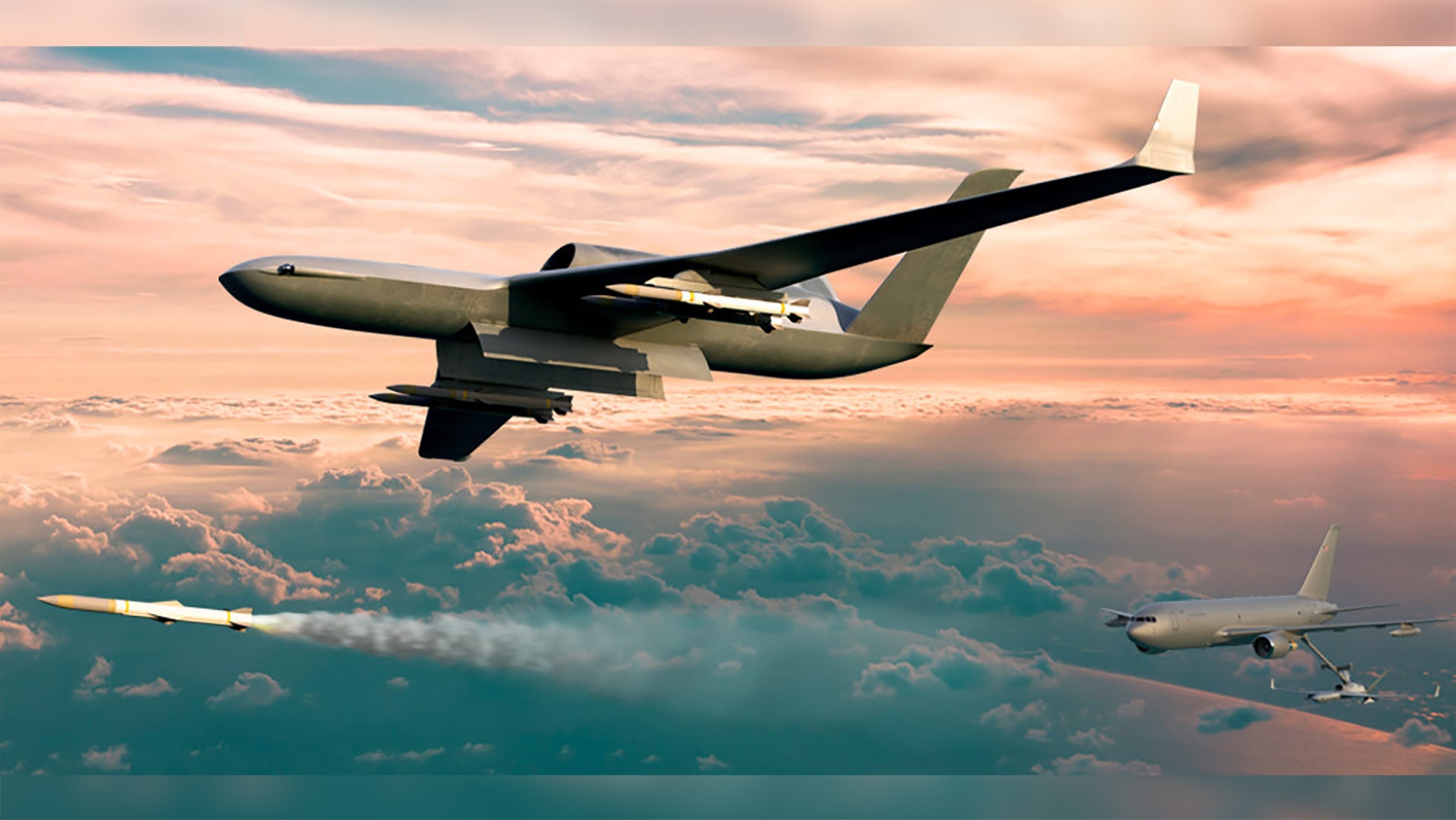General Atomics has revealed what appears to be a previously unknown unmanned aircraft concept, called Defender, that is capable of air-to-air combat and mid-air refueling. The company says that its primary mission would be to protect “high-value airborne assets,” such as airborne early warning and control aircraft, standoff reconnaissance planes, and aerial refueling tankers. Concept art of the drone appeared online a day after news broke that the U.S. Air Force is seeking to abruptly halt purchases of MQ-9 Reapers, one of the firm’s flagship products, something we at The War Zone noted would very likely lead to the disclosure of new potential business opportunities.
The official Twitter account of General Atomics’ Aerospace Systems division, or GS-ASI, posted an artist’s conception of the Defender on Feb. 27, 2020. The Tweet included hashtags for the Air Force Association’s 2020 Air Warfare Symposium, but at the time of writing, there does not appear to have been a major announcement about the project.
“Capable of protecting the @USAF’s high value airborne assets (HVAA) in a contested environment makes the Defender a critical piece of the Future Force,” is all the social media post says.
At least visually, the Defender appears to be derived from General Atomics’ submission for the Navy’s MQ-25 Stingray tanker drone program, which lost out to Boeing’s design in 2018. The company did not build a flying prototype for its proposed design, but did do associated work on developing its powerplant and control systems. Some of that research and development was done using one of its existing stealthy Avenger/Predator C drones.
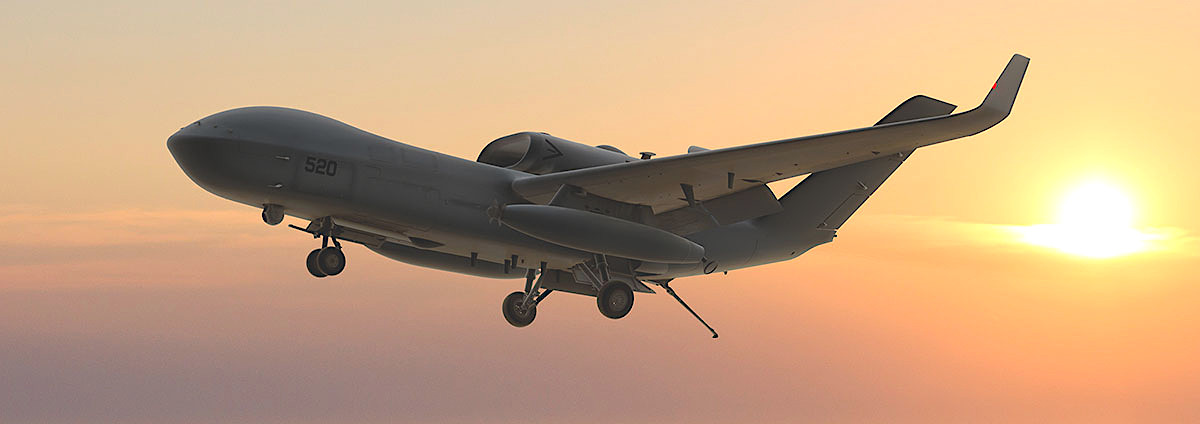
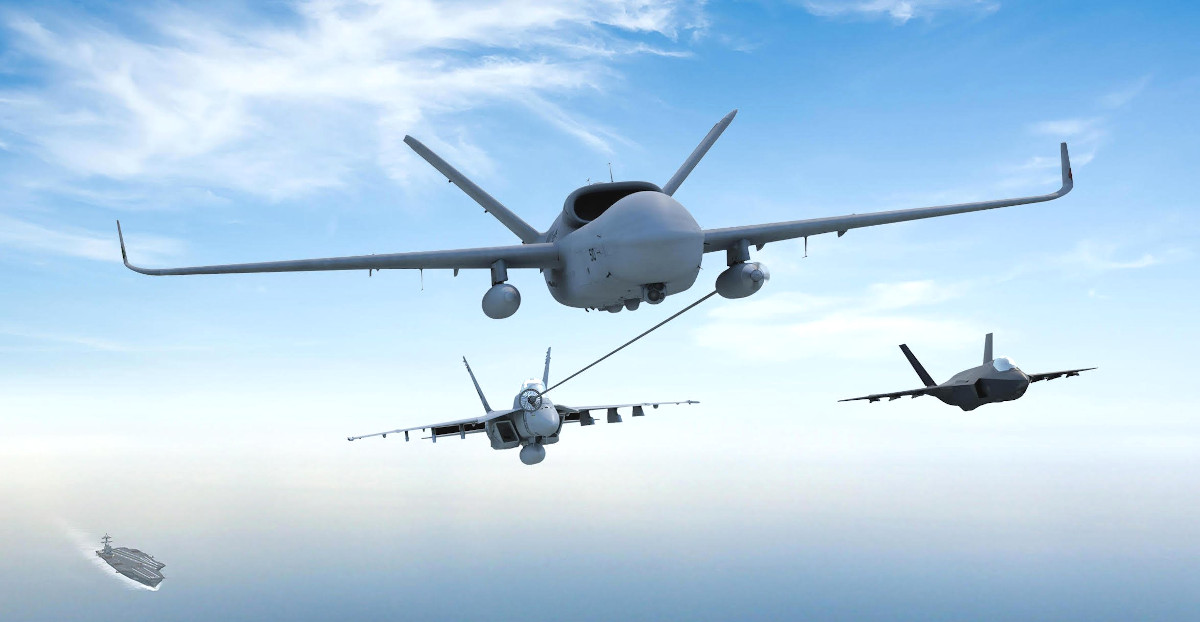
The Defender design in the artwork has a similar overall planform to the proposed Navy tanker design, but with the notable addition of an internal centerline weapons bay with large outward opening doors reminiscent of the ones of the Avenger/Predator-C. It also has a single pylon under each wing, a more streamlined forward-fuselage, and what appears to be an altered wing design with less camber than its carrier-based progenitor.
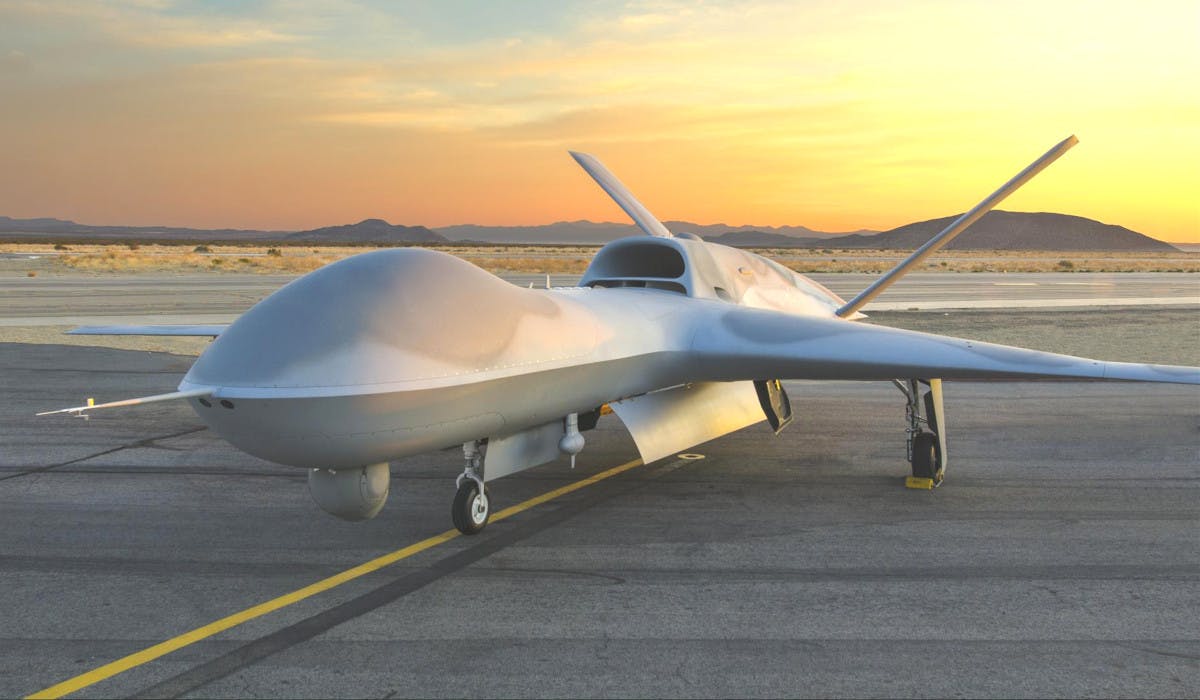

The concept art depicts one of the Defenders firing a compact missile, reminiscent of Lockheed Martin’s Cuda. That defense contracting giant first revealed Cuda in the early 2010s, but it since has all but disappeared from its marketing literature. It’s also carrying four AIM-120 Advanced Medium-Range Air-to-Air Missiles (AMRAAM) externally, two on each underwing pylon.

Another Defender is seen in the background of the artwork refueling via the boom on a KC-46A Pegasus tanker. This is exactly the kind of aircraft that General Atomics says the Defender would be well suited to protecting.
There is little doubt that lumbering Air Force support and force-multiplier aircraft are seen as vulnerable in a peer-state conflict, where vast distances can be turned into contested airspace with the help of the enemy’s anti-access/area-denial (A2/AD) capabilities. Fighter aircraft have a combat radius measured in hundreds of miles, usually roughly between 400 and 800 miles, with the F-15 being on the high-side of that spectrum, F-35 being right in the center, and aircraft like the F-16 and F/A-18 being on the lower end the spectrum.
Regardless, the idea that these aircraft need to stay so close to aerial refueling assets in order to execute their mission and return home to do it again is becoming increasingly problematic. The same can be said for the need to keep assets like airborne early warning and control (AEW&C) and other large surveillance aircraft within a couple hundred miles from the primary battlespace those fighters will operate in.
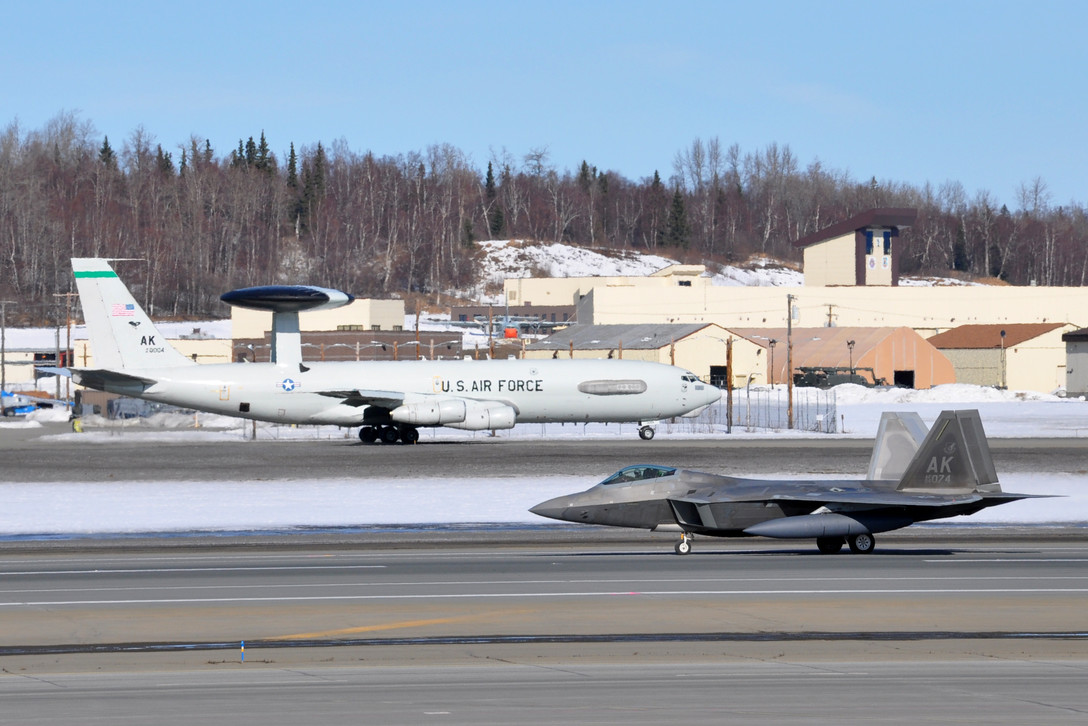
Developing more survivable tankers is one possible answer, or at least part of an answer, to this issue. This can be realized through low-observable (stealth) design and/or electronic surveillance, networking, and electronic warfare equipment. Nobody has talked about this issue more than The War Zone. You can read much more about it first here, and then here and here.
Another potential answer, or part of a cocktail of solutions to solve the problem, is to give tankers and other large support aircraft a loyal wingman drone that can act as a sentinel of sorts, providing an organic, rearward line of defense for these assets. This appears to be what General Atomics is going after with the Defender concept.
A drone with high endurance, aerial refueling capability, and the speed needed to keep up with tankers, AEW&C, strategic reconnaissance, other support aircraft, and in some cases even bombers, would provide a persistent inner anti-air screen for these assets. Battle management personnel on one of the aircraft in these formations could direct the drones to investigate and engage aerial threats via a semi-autonomous, point-and-click, desktop-like command interface.
The drones themselves would not have to rely on satellite beyond-line-of-sight (BLOS) data-links under such an arrangement as highly-reliable and jam-resistant line-of-sight data-links between the drones and the aircraft controlling them would be sufficient for this type of communications and command and control architecture. Even if BLOS connectivity was used and someone from thousands of miles away were to control the drones, it’s still possible to use one of the tankers or other support aircraft’s wide-band satellite links to do this, instead of each drone being connected by their own onboard satellite link simultaneously.
In other words, a localized unmanned protection concept for these vulnerable aircraft also simplifies the communications architecture needed to execute such a concept.

Taking the human out of the cockpit would also provide better ease in executing very long-range escort missions that can be harsh on fighter aircrews. Whereas the person manning the control console on a tanker or AEW&C aircraft can swap out with another crewman in order to go get rest, fighter crews have no such option. They can’t even stand up and stretch out in the cockpit. They also require constant refueling.
The aerial threat is certainly tangible enough for these large aircraft as China, and to a degree, Russia, have focused on designing capabilities and tactics that exploit America’s short-range tactical airpower ‘Achilles heel.’ China’s long-range and stealthy J-20 fighter poses a substantial threat to these assets—it was designed specifically to do so—as do new very long-range air-to-air missile capabilities that China is developing. As such, the Defender concept makes sense, especially seeing as fighter aircraft will already be taxed to the limit just trying to prosecute an air war, let alone being dragged over thousands of miles to protect a formation of tankers and other support aircraft.

Even with fighter screening, playing in someone else’s A2/AD backyard means numerical superiority for the enemy. A fighter can carry only so many missiles or engage so many targets at once. Having a secondary counter-air inner screen may not just be relevant, it may be essential. The aircraft providing that inner screen can also be adapted and equipped specifically to do so in ways fighters can’t.
Defender-like aircraft could also presumably prosecute pop-up threats on the surface of the earth using standoff munitions, but this would likely be a secondary capability, with naval-based air defense threats posing the biggest danger. These drones can also carry unique sensor combinations aloft and help feed that information into the larger data-network situational awareness and targeting ecosystem.
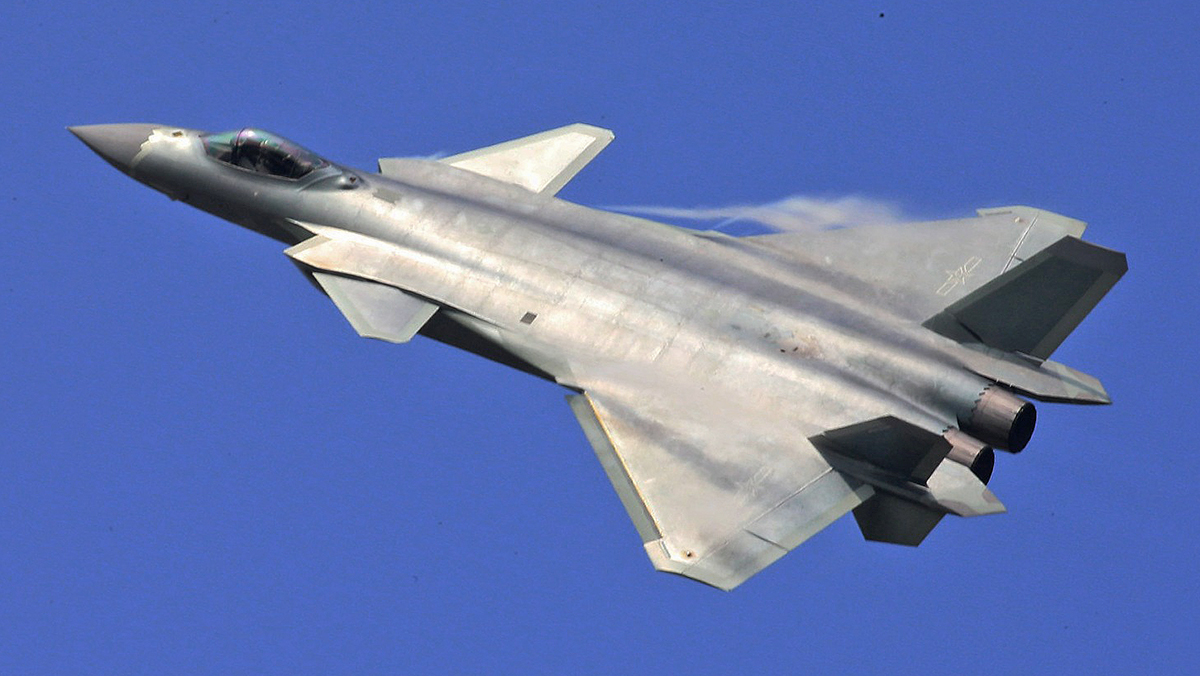
A Defender-like drone would likely be equipped with an AESA radar, radar homing and warning reciever/electronic support measures, missile and approach warning system, and an infrared search and track system (IRST). This would give the aircraft four layers of organic target and situational awareness gathering data—both of an active and passive nature—that could be used not just to engage potential threats, but to have a formation of support assets avoid them as needed. The IRST would be essential as it is the best early warning tool for detecting stealthy aircraft and long-range missile launches. Additionally, and maybe more importantly, a Defender could also provide electronic warfare self-escort support for the aircraft under its protection. Their operator would also benefit from all the information being piped into the network from combat aircraft operating forward over the battlespace and other surveillance assets.
These same aircraft could also eventually be equipped with a laser system capable of shooting down incoming missiles and even working to deny enemy aircraft the ability to advance on these high-value assets. This concept is already in development, as are hard-kill systems that are capable of shooting down missiles with smaller missiles. This could actually be what we are seeing by the portrayal of the Cuda-like missile in General Atomics’ concept art.
By pushing sensors and weapons onto a combat drone airframe, it would mean that each tanker or other support plane wouldn’t need its own defensive suite, which would not be useful for nearly all missions outside of combat ones against a peer-state. In other words, those systems would be costly dead weight flown on those aircraft daily in peacetime and on operational missions that don’t venture near contested airspace. So, by fielding a Defender drone force to protect strategic aerial assets, the many aircraft that make up that large fleet of those assets would not have to all be equipped with these expensive subsystems, or some combination of them. These savings could help offset a portion of the costs of fielding a Defender fleet.
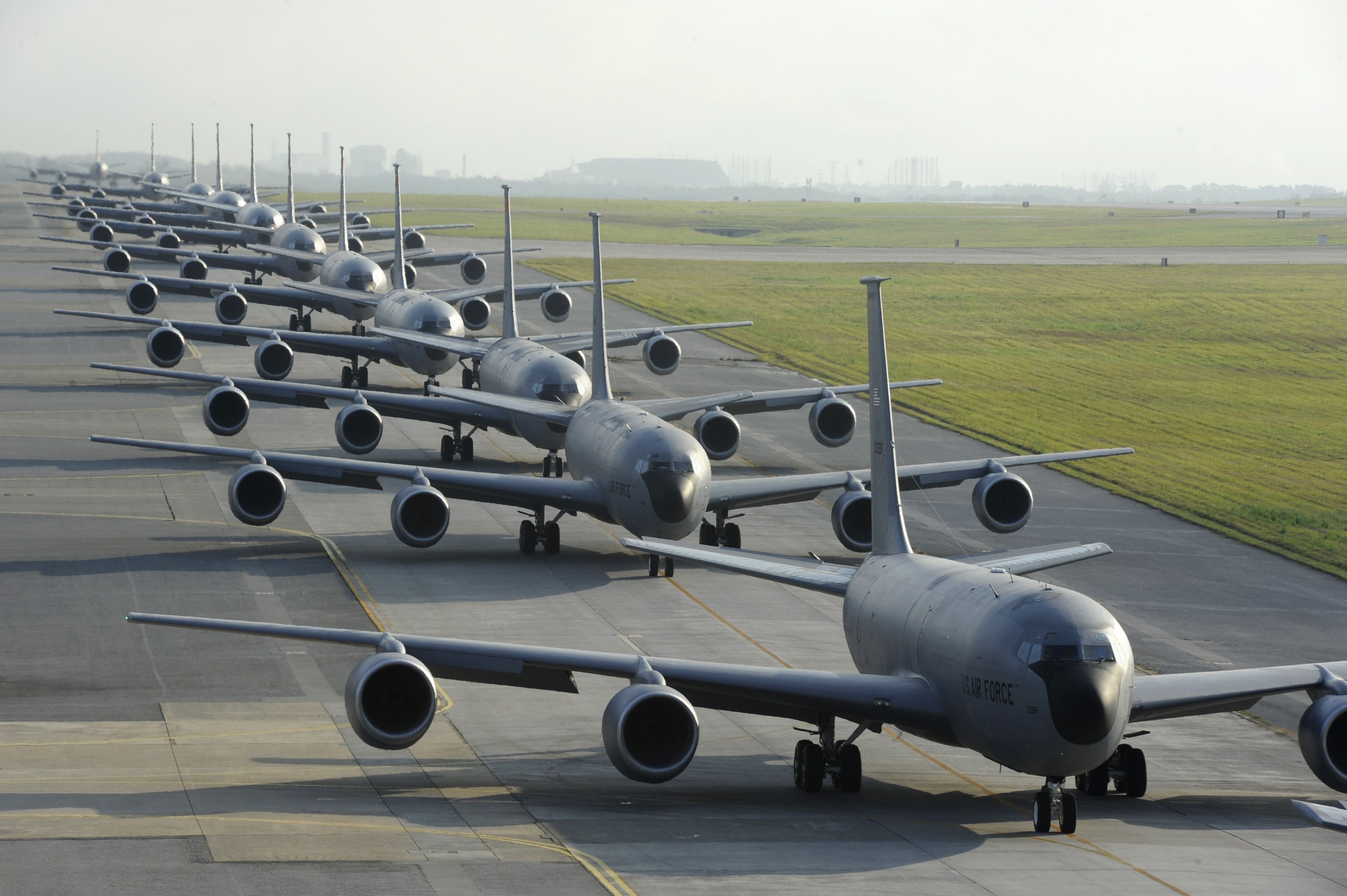
One thing General Atomics’ Defender concept does not have is a high-degree of low-observability (stealth). As a result, this does make it another target along with the tankers. But considering the tankers are already a target, the advantage of a low-observable escort aircraft is somewhat limited, but not irrelevant. These Defender drones would be less survivable than a low-observable alternative and would be less capable of dynamically countering enemy air-to-air fighters. In exchange, they would likely offer efficiency, easy adaptability, greater payload flexibility and depth, and potentially a lower cost, both in terms of acquisition and operation. Considering their proposed mission set is solely to protect high-value assets, that doesn’t sound like a terrible trade.
Then again, if there were large numbers of multi-role, stealthy, unmanned combat air vehicles (UCAV) in the Air Force’s fleet, why exactly would this separate design be justified? It may bring some payload advantages, such as the ability to easily integrate a laser system, and range efficiencies to the table, but any UCAV is already going to have a combat radius that is a multiple of its fighter counterparts. A single UCAV design could work on its own, in a swarm, as a loyal wingman to a manned fighter, or as a loyal wingman for large high-value assets. With this in mind, if anything else, the Defender concept highlights yet another glaring application for a large, multi-role, low-observable UCAV force.
Still, a design that is more of a sensor and weapons truck focused on protecting the inner sanctum around high-value aerial assets as they steadily draw great contrails across the sky is certainly an intriguing proposition.
What do you think of General Atomics’ Defender concept? Let us know in the comments below.
Contact the author: Tyler@thedrive.com
